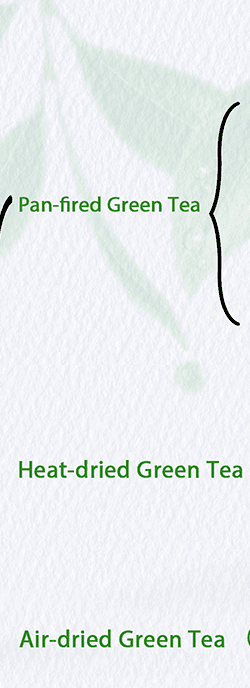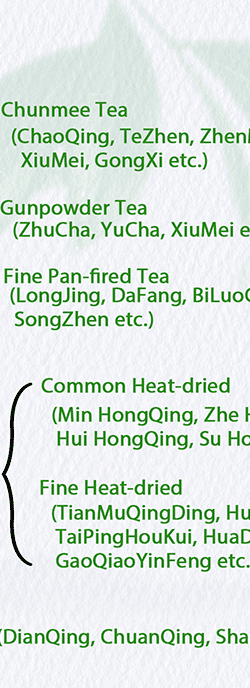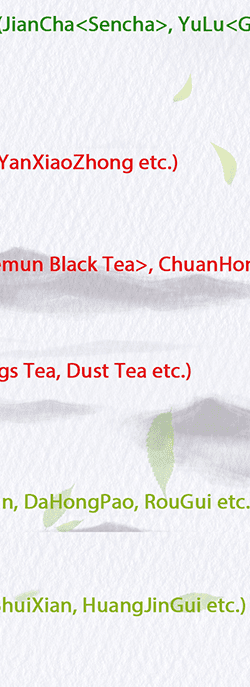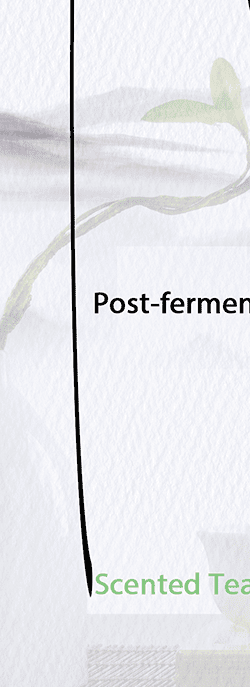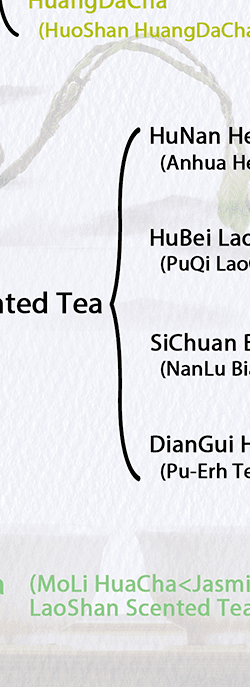Introduction au thé chinois


Introduction au thé chinois
China is the source of tea tree planting and tea drinking. Tea trees and skills on tea collecting and making are directly or indirectly introduced from China. The pronunciations of tea in different cultures are all from Chinese local dialects. China is rich in tea sources. There are more than 20 provinces and districts producing tea all over China.
There are many tea classifications in China; according to the different degree of fermentation, tea can be divided into non-fermented tea, semi-fermented tea, fully-fermented tea; according to the tea manufacturing process tea can be divided into six basic teas and re-processing tea. The six teas are green tea, black tea, Oolong tea, yellow tea, white tea and dark tea; Re-processing tea, namely, scented tea, condensed tea, extracted tea, medicinal tea, fruit tea and tea food. Among them, six teas and scented tea are the most common tea, with which most people are familiar.
一、Green Tea
-
Steamed Tea
Steamed tea is also called Sencha. It is a green tea named by Japan. It is made from leaves of Japanese tea bush varietals such as Yabukita. During processing, it is rolled into a needle-like shape, steamed and then dried, sorted and blended. It is first imported from China in Ming Dynasty. In recent years, this kind of tea has been produced in china according to the process procedure of Japan, especially in zhejiang province. This tea is also called steamed green tea in china due to dehydration of tea leaf by steam treatment. It owns the character of deep dark green appearance, green-yellowish liquor and greenish color of brewed tea leaves, we called it as three green integration.2. Chunmee Tea
-
Chunmee Tea
Chunmee Tea(eyebrow tea) gets its name from the curve of the processed leaf. It was thought, when viewing the beautifully shaped leaf, that it resembled that of a woman’s finely formed eyebrow — as opposed to an older man’s bristly brow. Great skill is required to produce this very high-quality green tea. The fine eyebrow-shaped leaves produce a clear, yellow-greenish brew with a distinctive sweet, plum-like flavor.
-
Gunpowder Tea
Gunpowder Tea is Chinese green tea named for the way the tea leaves are rolled into small pellets, which look like old-fashioned gunpowder. Rolling the tea leaves helps preserve its fresh flavor, produce aromatic, light liquor which opens with a crisp astringency and develops into a well-rounded sweetness with a lingering, mellow finish.
-
Wild Tea
This product is made from the fresh and quality wild tea growing 1000M above the sea level in organic tea garden. With the guidance from the senior tea technical staffs, this product is a kind of tea by manual work with no pollution, no poison on it.
It has tight, curly and tippy shape. Its dried tea color takes on green jade and bloom. It has heavy and strong fragrance and fresh, sweet and mellow taste. The tea residue takes on tender green and bright. This product is a superior one in tea.
-
Coarse Tea
This tea was processed very simply. It reserve whole of nutrients in the fresh tea leaves. So it was called the real tea.However the shape of original tea isn’t very beautiful as the simply processing. But the nutrition is best and with competitive price.
-
Bud Tea
The bud tea is a full-flavored green tea. It grows in organically tea garden, was picked one bud and two tiny leaves in early spring and hand-processed according to ancient methods. It’s a full-leaf tea, not dust, offering rich tea. It can’t be boiled and drunk many times. It’s the freshest and highest quality loose leaf tea.
二、Black Tea
-
Lapsang Souchong
This special type of black tea from the Fujian province of China comes this very distinctive tea with its exotic smoky flavor. After plucking, the leaves are withered over cypress or pine wood fires. After the rolling process, they are placed into wooden barrels until they begin to emit their own pleasant aroma. As a final step they are placed in bamboo baskets and hung on racks over smoky pine fires where they dry and absorb the essence of the smoke.
-
Gongfu Black Tea
Gongfu black tea is a traditional product of China, especially famous for its delicacy in shape, color, fragrance and flavor. Main tea provinces: Anhui, Yunnan, Fujian, Hubei, Hunan, Shichuan, etc.
三、White Tea
-
Thé Silver Needle
White tea from China. Silver Needle is among the most revered of Chinese teas, produced in the Fuding and Zhenhe districts of its Fujian province. Gathered only in the few days of early spring, the preparation of this tea is governed by strict requirements to ensure a premium product. This dedication to perfection is evident in the cup, which is sweet and delicate with a clean, airy fragrance. Our ‘Sublime Needle’ is a Special Grade (Bai Hao) version of this exquisite tea.
-
Bai Mu Dan(White Peony Tea)
White teas are the most delicate of all teas. They are withered & dried only, so the leave appearance is essentially unaltered. Bai Mu Dan is made from the bud and leave. The silvery bud is enfolded by green leaves, and it looks like a flower. When steeped, the green leaves unfold resembling petals of a peony blossom. That just as an inchoately blooming white peony, hence the tea is named “white peony tea”. There is a fine white down that covers the long slender bud. When infused the flavour is slightly smoky and slightly sweet and the cup colour is a pale yellow. This is an excellent Bai Mu Dan, which is great any time of the day or night. Medically white tea is refreshing and is good for the stomach. It can also be used to dispel the heat.
四、Yellow Tea
Yellow Tea is a non-fermented or non-oxidized tea. It is very similar to Green Teas except with an additional step that results in the finished tea leaves having a natural light yellow color. Golden Needles also known as Jin Yin Zhen consists of only singular young tender buds hand-picked before they open and mature. During the imperial period in China, Yellow tea was highly prized for this slight yellow tea leaf color, the color of royalty.
-
Huang Da Cha
Dayeqing tea is a specialty of Guangdong. Dayeqing tea is also called Guangdong dayeqing. It is mainly produced in Shaoguan, Zhaoqing, Zhanjiang and other counties and cities in Guangdong province. It belongs to yellow tea and is one of the representative varieties of Huang Dacha, but unlike other methods of making yellow tea, it method of making tea is to wither first, then dehydrate, and then twist and stuffy heap. The main purpose of withering before dehyrdating and stuffy heaping after twisting is to eliminate the smell of grass and astringency taste of tea and then promote the mellow and pure fragrance. The quality characteristics of Guangdong Dayeqing are that the appearance of the strip tea is bold, tight, heavy, tender and even, the leaves are intact and tippy fully, the color is green bloom with little yellow, the aroma is pure and normal, the taste is heavy, mellow, and sweet after taste, the soup is orange and bright, the bottom of the leaf is light yellow. The products are divided into 1-5 grades.
-
Huang Xiao Cha
Huang Xiaocha, a type of tea, belongs to the yellow tea series. It is made of fine bud leaves, mostly one bud and one leaf, and one bud and two leaves as raw materials. Its quality is not as good as that of yellow bud tea, but it is obviously better than that of Huang Da Cha. The more famous varieties of Huang Xiao Cha include “Wanshan Maojian” in Ningxiang, Hunan, “Beigang Maojian” in Yueyang, Hunan, “Yuanyuan Luyuan” in Yuan’an, Hubei, and “Pingyang Huangtang” in Wenzhou and Pingyang, Zhejiang.
-
Huang Ya Cha
Huoshan huang ya tea was already well-known as a famous tea in Tang dynasty. While the production skill of Huoshan huang ya cha has ever been lost in the hundreds years before 1971.
Huoshan huang ya cha is mainly produced in the Huoshan area of Anhui province. The tea leave looks like the tongue of sparrow. The tea is fine and tender, covered by hairy tip. Because of a special processing step named “yellowing”, the tea leave show yellow in color. The cup color of Huoshan huang ya cha is olivine. It smells fresh and refreshing, somewhat with chestnut fragrance. The taste is mellow and thick. The tealeaves after infusion are tenderly yellow.
The name Huangya means “Yellow Sprout”. The beautiful leaves are a mixture of jade green, yellow and white colors. Single small leaves with hairy tips create this nutty and smooth Tea with a gentle, sweet finish.
五、Puer Tea
-
Pu-Erh Cake Tea
Pu-Erh Tea is one of the ten most famous teas in China. Pu’Er is a large leafed tea from the Yunnan province in China and has been famous as a medicinal tea. The earliest records of Pu’Er tea date back to the Tang Dynasty ( 618AD-906AD ) when it was the favorite tea of the nobleman of this time. Pu’er tea over the centuries has been used as a form of currency in China and an important international trading item. Pu’re tea was at one time very well known in northern Canada among the northern native people, who were trading across the Bering Strait. Pu’Er tea derives its name from the market town of Pu-er, where it was originally processed and sold, but it is grown on the Nuoshan Mountains. It is said that the unique taste of? Pu’Er Tea was developed because it took weeks to transport the tea leaves by horseback to the town to be processed. During this transportation period the tea leaves would begin to ferment in the humidity and release a strong, fragrant aroma, which people found quite pleasant. A special technique of tea fermenting developed and Pu’er was thus created.
The secret of making Pu’er tea has been closely guarded in China for centuries. The tea leaves are collected from growers of a special broad-leaf tea tree, which are said to be related to ancient prehistoric tea trees. The leaves go through two types of fermentation, which gives this tea its unique characteristics; a mild, but distinctively earthy flavour. Pu’er requires a minimum of 10 years to mature and gets only better with age. Pu’er teas are much like fine wines, which become smoother and more balanced with age. Pu’Er teas are much lower in tannins than other teas due to the special processing method which it undergoes.
Pu’Er tea has been celebrated since the Tang Dynasty (618AD-906AD ) for its health benefits and curative powers in certain diseases. Modern medical science has recently shown that the health benefits of Pu’er tea may be more than just Chinese folklore. Since 1970 France, Japan and China have been conducting many scientific studies on Pu’Er tea which suggest that it may: reduce cholesterol in the blood stream reduce body weight; help to reduce high blood pressure, heart & liver diseases related to high saturated fat diets detoxify the liver; help prevent intestinal infection, digestive problems and constipation; help to prevent the formation of cancer cells in the body due to its anti-oxidants. There are pu’er loose leaves tea, cake tea, brick tea, bird’s nest’ tea, arts and crafts pu’er tea.
-
Pu-Erh loose leaves Tea
-
Pu-Erh Brick Tea
-
Pu-Erh Bird’s Nest’ Tea
-
Pu-Erh Arts and Crafts Tea
六、Oolong Tea
-
Fujian Oolong
1.) Ti Kuan Yin
Ti Kuan Yin tea is one of the ten most famous teas in China which translated as “Iron Goddess of Mercy”, is worldwide well-known Chinese Oolong tea. The dry tea leaf of Ti Kuan Yin is much heavier than other Chinese tea. In China, it is described by such words as “weigh like iron”. The unique flavor of Ti Kuan Yin tea praised by Chinse tea farmers as the present bestowed by Kwan-yin (Kwan-yin: A goddess in Chinese fairy tale). Hence, Ti Kuan Yin tea is so called. The original producing area of Ti Kuan Yin tea is Xiping Village of Anxi County in Fujian province. Till now, the production of Ti Kuan Yin tea in Anxi has lasted more than 200 years. The appearance of Ti Kuan Yin tea is “dragonfly head, spiral body, frog leg, mogalsar geen leaf covered with white frost, heavy body”. When steeping, Ti Kuan Yin tea is firstly tasted mellow with strong fragrance. After veral infusions, the Ti Kuan Yin’s fragrance is still remaining. At the same time, a sweet after taste quickly rise from the throat. Indeed, it’s hard to correctly describe the Ti Kuan Yin’s flavor. Right or wrong, Ti Kuan Yin’s unique flavored is named as “Kuan Yin flavor”. Also, Ti Kuan Yin tea wins the reputation of “lingering fragrance remains after seven times infusions”.
2.) Rou Gui
Rou Gui is the latest tea added to Wu Yi’s famous five bushes (previously only four consisting of Tie Luo Han, Shui Jin Gui, Da Hong Pao and Bai Ji Guan; referred to as Si Da Ming Cong). All these teas originate from Mount Wuyi in Northern Fujian of China. This tea leaves is picked with special care by only choosing the best leaves.
-
Guang Dong Oolong
1.) Phoenix single bush
Phoenix single bush come from GuangDong Cao’an district’s Phoenix Mountains.The outstanding single bush with idiosyncracy in the Phoenix Narcissus variety colony is selected and plucked to produce Phoenix single bush. According to the various nuances in taste and fragrance, Phoenix single bush can be further categorized into more than 80 varieties, such as “Huang Zhi Xiang”,” Rou Gui Xiang”, “Xing Ren Xiang” etc. long, twisted leaves show with yellow auburn color. When infused, the gentle natural floral aroma and mellow, brisk taste will farthest satisfy your palate and nose. Phoenix single bush is definitely differentiated from other Single bush Oolongs by its special “mountain rhythm”. The liquor of the cup is clear like tea oil. The tealeaves after infusion are green with red edge.
-
Tai Wan Oolong
1.) Taiwan Ali Mountain Oolong Tea
Taiwan Ali Mountain Oolong Tea grows at Ali Mountain, 1300 of elevation. In the thick fog surrounds perennially, the temperature is low, the tea produced draws on the quintessence of sun and moon revealed. So its fragrant smell is original and special, fragrance overflows in the entry sweetly and fragrantly, for its special point.
七、Scented Tea
-
Jasmine Green Tea
Jasmine Tea is one of the ten most famous teas in China. Jasmine Tea is a famous tea made from Green or Pouchong (Chinese Green) tea leaves that are scented with jasmine flowers. The jasmine flowers are harvested during the day and stored in a cool place until night. During the night, the flowers bloom with full fragrance. The flowers are layered over the tea leaves during the scenting process. The quality of Jasmine tea is determined by the quality of green tea used as its base and the effectiveness of the scenting.
-
Jasmine Silver Needle
Jasmine Silver Needle is produced in Fujian Tea District. It uses fresh spring leaves of white silver needles to make heat-dried green tea, and then scent with jasmine flowers. The tea strips are tight and needle-like, even and straight, covered with fully tippy, the aroma is fresh, brisk and heavy, and the soup is clear and bright. Tea buds rise when brewing, and snowflakes fall when sinking, it is a wonderful spectacle.
-
LaoShan Scented Tea
It is made of high-quality Laoshan green tea embryos and scent with high-quality jasmine flowers. The appearance of the strip tea is tight and even, the color of its dried tea is yellow and green bloom, and the aroma of the tea is fresh and heavy flavor, It has a clear fragrance of flowers, the soup is light yellow and bright, and the brewed leaf is fine, tender and bright. It is an unique to the market.
Chinese Tea Diagram





Catégorie Blog





Catégorie de produits





Catégorie de magasin
Recherche
Messages récents
- How to Bew an Exqusite Cup of Efoofan Organic Dragon Well Loose Leaf Tea
- How to Brew a Good Cup of Organic Longjing Tea? 3 Ways
- Résumé de l'activité antioxydante du thé
- Politique de mise en œuvre de la production durable des jardins de thé biologique
- L'histoire de l'industrie du thé biologique à Lin'an
Commentaires récents
- ukuran sepatu dans Vision, Mission, Strategy & Principles of EFOOFAN Organic Tea
- tea burn dans Vision, Mission, Strategy & Principles of EFOOFAN Organic Tea
- liv pure supplement dans Vision, Mission, Strategy & Principles of EFOOFAN Organic Tea
- idle breakout hacks dans Vision, Mission, Strategy & Principles of EFOOFAN Organic Tea
- Perawatan kulit De-hair dans Vision, Mission, Strategy & Principles of EFOOFAN Organic Tea







